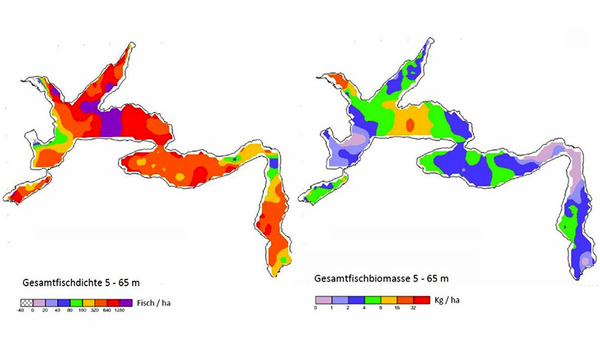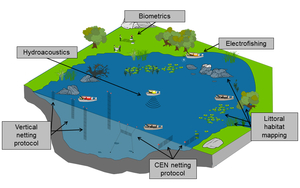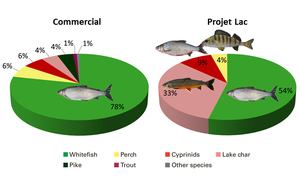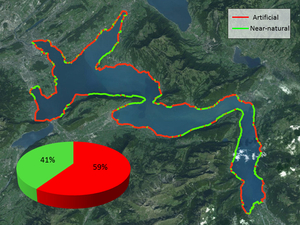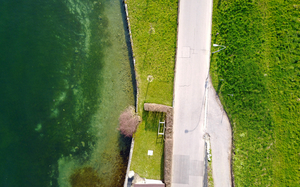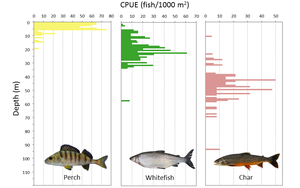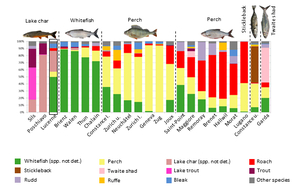News Detail
Detailed picture of Lake Lucerne’s fish fauna
July 19, 2017 |
To date, our knowledge of fish species occurring in lakes has been based mainly on the catches of fishermen and anglers. However, because these groups concentrate on particular species and size categories, their catches do not reflect the actual composition of the fish community. For this reason, Eawag joined forces with federal, cantonal and research partners to launch “Projet Lac”, which is designed to assess and compare the fish fauna in various prealpine lakes, using standardized methods. Surveys were conducted with the aid of sonar, sampling nets of different types and mesh sizes, and electrofishing of littoral habitats (Fig. 1). The specimens caught were identified, weighed, measured and photographed. A reference collection has been established at the Natural History Museum of Bern, including at least 30 individuals per species per lake.
Fig. 1: Fish stocks were assessed using a variety of complementary methods.
Surveys were conducted by means of sonar (hydroacoustics), vertical and horizontal sampling nets with different mesh sizes (benthic and pelagic netting), and electrofishing of littoral habitats. (CEN = European Committee for Standardization)
Dominant species: whitefish and char
The findings for Lake Lucerne have now also been published. Here, 252 sampling measures were carried out over a period of six days, yielding 2479 specimens of at least 21 different fish species. The species most frequently caught, by a clear margin, was perch. Also well represented were bleak, roach, “Albeli” (the whitefish Coregonus zugensis), char and non-native ruffe. However, because sampling did not cover all habitats to the same degree, the catches were adjusted for habitat availability. It was thus shown that the dominant fish species in Lake Lucerne are whitefish and char.
Alternatives to whitefish and perch for diners?
As expected, commercial catches differ markedly from the standardized “Projet Lac” catches. While “Albeli” and other whitefish species account for more than three quarters of commercial catches, they only made up about half of the total in “Projet Lac”. At the same time, char and the various cyprinid species (carp family) made up a much larger proportion of “Projet Lac” catches (Fig. 2). Does this mean that the efforts of Lake Lucerne’s fishermen should be directed towards other species? Project coordinator Timothy Alexander says: “I can’t make any recommendations based on our data alone. At the very least, we’d need to know more about the reproduction and growth of other species. For it’s quite possible that they’re only so common at present precisely because people aren’t fishing for them.” One would also need to make sure, he adds, that alternative species would not be rejected by consumers.
Lakeshore: almost 60 per cent modified by human activities
Natural and richly structured lakeshore habitats are important for fish diversity. For this reason, the ecological status of littoral zones was also assessed in “Projet Lac”. For Lake Lucerne, it was shown that only about 41 per cent of the shoreline is in a near-natural state, while 59 per cent is more or less heavily modified, with level lakeside areas and tributary mouths being particularly affected. In these areas, the need for ecological enhancement is especially high (Fig. 3a, 3b).
Which parts of the lake are occupied by fish?
Fish are not randomly distributed in a lake. Although – because of the favourable oxygen conditions in Lake Lucerne – fish could be caught at depths of up to 100 metres, the highest density of fish was found between 0 and 10 metres. It is interesting to note the depth distribution of catches in the pelagic zone: in the summer, when sampling was carried out, populations of perch, whitefish and char were clearly segregated by depth (Fig. 4).
Fig. 4: In Lake Lucerne, perch, whitefish and char (including deep-water char) are clearly segregated by depth. CPUE = catch per unit effort (i.e. number of fish caught, adjusted for net area).
Distinctive community composition
Lake Lucerne is an example of an originally oligotrophic lake which experienced a period of eutrophication from the early 1950s to the mid-1990s. Today, the fish fauna is again typical of an oligotrophic lake. However, compared to other oligotrophic lakes which were never exposed to higher nutrient inputs, the proportion of whitefish is somewhat lower, while char are particularly abundant. Thus, in terms of species composition, Lake Lucerne occupies an intermediate position between a typical whitefish and a typical char lake (Fig. 5).
Fig. 5: Comparison of fish fauna in various lakes. “Lucerne” refers to the whole of Lake Lucerne (excluding the Lake Alpnach arm).
Surprising discovery
Of all the prealpine lakes studied in “Projet Lac”, Lake Lucerne has the highest density of char. Higher char densities were only observed in mountain lakes such as Lago di Poschiavo and Silsersee. Particularly gratifying is the rediscovery of the historically described deep-water char in the Urnersee. Overall, an impressive variety of forms of char were found in Lake Lucerne; whether these are “merely” ecotypes or actually distinct species can only be determined by further investigations (see Box). The results of “Projet Lac” show that standardized sampling of all lake habitats is required to obtain an objective assessment of fish community composition. The picture provided by these findings differs markedly from commercial catches, which are focused on whitefish species, and the standardized methods used in “Projet Lac” mean that different lakes can now be compared. Finally, this snapshot provides a baseline for monitoring the future development of fish fauna in Lake Lucerne.
Small salmonid found in the depths of Lake Lucerne
Like trout, char belong to the salmonid family. In Switzerland, two species of deep-water char have been described to date – one endemic to Lake Neuchâtel, and one to Lake Constance. Both were assumed to be extinct, but several specimens of the Lake Constance species (Salvelinus profundus) were found by “Projet Lac” researchers in 2014. Around 1950, a form of char living in the depths of Lake Lucerne was documented by Paul Steinmann, but it was never described taxonomically or officially named and does not appear on any species lists. Since that time, this form has never been officially recorded, although specimens differing from other char have occasionally been caught by fishermen. Genetic investigations should now establish whether the fish occurring at depths below 60 metres are a distinct species or an ecotype of the lake char. At any rate, according to project coordinator Timothy Alexander, this fish is more closely related to other char in Lake Lucerne than to the deep-water char of Lake Constance. It appears to spawn in the depths of the lake in the summer, as the specimen retrieved was a female with eggs.
Compared to the normal type, the char found in the deep waters of Lake Lucerne is much smaller, with larger eyes, a different body shape and paler coloration.
A shorter version of this article (in German) was published in the information magazine (6/2017) of the Lake Lucerne Supervisory Commission.

